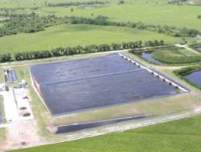Algae Turf-Scrubbers Clean Water and Provide Fuel

An article published in the June issue of BioScience describes the early scale-up stage of a new biotechnology with environmental benefits and possible commercial potential. Algal turf scrubbers are field-sized, water-treatment systems that can extract excess nutrients from streams, canals, and lakes polluted by agricultural, domestic, and some industrial runoff.
They use sunlight as their principal source of energy and simultaneously restore oxygen levels. The devices work by pulsing contaminated water across algae that are allowed to grow on screens. Algal turf scrubbers produce waste suitable for use as a nitrogen- and phosphorus-rich fertilizer and for conversion to biofuel or high-value nutraceuticals. Some can even operate in open water, minimizing loss of agricultural land to the systems.
The BioScience article, by Walter H. Adey of the Smithsonian Institution, Patrick C. Kangas of the University of Maryland, and Walter Mulbry of the U.S. Department of Agriculture, notes that the need to clean wastewater and various types of runoff contaminated with nitrogen and phosphorus is immediate in many places where natural waters are polluted. Furthermore, some ecologists are worried about global supplies of phosphorus for use in fertilizer, so the byproduct could become more valuable over time.
The article stresses that algal turf scrubbing is not likely ever to be profitable purely as a way of making fuel. Although more productive than terrestrial crops, algae, as with other potential sources of biofuel, are expensive to cultivate, harvest, process, and convert into useful amounts of energy. But algal turf scrubbing could become common if the economic value of nutrient removal can be applied to the cost of building and running the units. That might depend on public policy that imposes a predictable cost on pollution of natural waters. But the fuel, fertilizer, and nutraceutical by-products from algal turf scrubbing can only help.